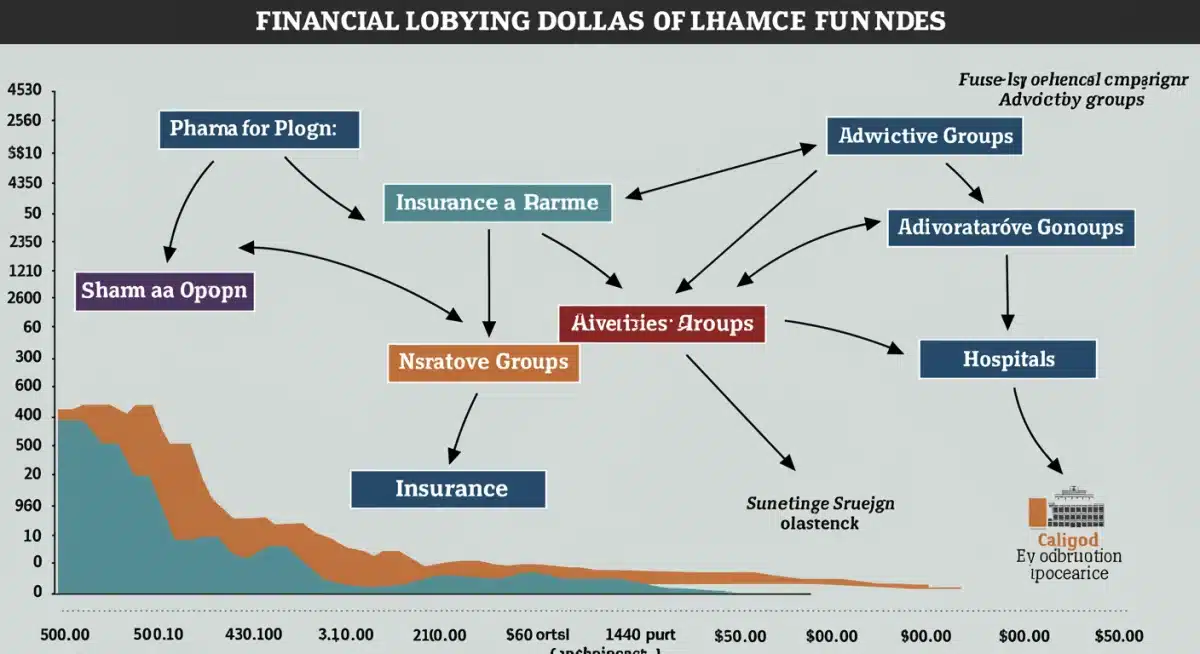Lobbying Curtain: Key Players Influencing 2025 US Healthcare Policy

The 2025 US healthcare policy landscape is being actively shaped by a complex web of lobbying efforts, with pharmaceutical companies, insurance providers, and patient advocacy groups playing pivotal roles in influencing legislative outcomes.
Ever wondered what truly happens behind the lobbying curtain: key players influencing 2025 US healthcare policy? The intricate dance between powerful organizations, elected officials, and public interest groups is constantly reshaping the future of American healthcare. This exploration offers an insider’s look into the forces at play, revealing how decisions are made and whose voices carry the most weight.
The Pharmaceutical Industry: A Colossus of Influence
The pharmaceutical industry stands as one of the most formidable forces in US healthcare lobbying. With vast resources and a direct stake in drug pricing, patent protection, and regulatory frameworks, pharmaceutical companies invest heavily to shape policies that favor their interests.
Their influence extends beyond mere campaign contributions, encompassing sophisticated public relations campaigns and direct engagement with lawmakers to advocate for specific legislative outcomes. As 2025 approaches, their focus remains sharply on issues impacting drug development, market access, and profitability.
Strategies for Policy Shaping
Pharmaceutical companies employ a multifaceted approach to influence policy. This often involves a combination of direct lobbying, coalition building, and funding research that supports their positions.
- Direct Lobbying: Engaging directly with members of Congress and their staff to discuss proposed legislation, offer insights, and advocate for amendments.
- Grassroots Advocacy: Mobilizing patient groups and medical professionals to support or oppose specific policies, presenting a unified front.
- Public Relations Campaigns: Investing in media campaigns to shape public opinion on critical issues like drug pricing or innovation.
- Research Funding: Sponsoring studies and reports that highlight the economic benefits of their products or the challenges of drug development.
The industry’s lobbying efforts are often centered on preserving the existing patent system, which grants them exclusive rights to market new drugs for a period, and resisting measures that could lead to government-negotiated drug prices, which they argue would stifle innovation. Their financial contributions to political campaigns are substantial, ensuring access and a platform for their concerns.
Ultimately, the pharmaceutical industry’s role in influencing 2025 US healthcare policy cannot be overstated. Their strategic investments and sustained advocacy are designed to maintain a favorable regulatory and economic environment for their products and future innovations, directly impacting drug accessibility and affordability for millions of Americans.
Insurance Providers: Navigating the Regulatory Labyrinth
Insurance providers are another critical player in the healthcare policy arena, constantly working to influence regulations that govern coverage, premiums, and market competition. Their lobbying efforts are particularly intense around issues like the Affordable Care Act (ACA), Medicare, and Medicaid.
The financial stability and profitability of insurance companies are directly tied to health policy decisions, making their engagement in the legislative process a top priority. They seek to balance consumer demands with business imperatives, often pushing for policies that reduce administrative burdens and increase flexibility in product offerings.
Key Legislative Priorities
For insurance providers, the upcoming 2025 policy discussions will likely revolve around several core areas. These priorities are shaped by a desire to maintain market stability and ensure a predictable operating environment.
- ACA Modifications: Advocating for changes to the ACA that could affect subsidies, mandates, or benefit requirements, aiming for more flexibility.
- Medicare Advantage: Protecting and expanding the role of private plans within Medicare, arguing for their efficiency and choice for beneficiaries.
- Medicaid Expansion: Influencing state-level decisions on Medicaid expansion and funding mechanisms, which directly impact their enrollment numbers.
- Regulatory Relief: Pushing for reduced regulatory oversight that they claim can stifle innovation and increase operational costs.
The insurance industry often emphasizes the importance of market-based solutions and consumer choice. They argue that excessive regulation can lead to higher costs for consumers and limit the types of plans available. Their lobbying efforts frequently involve presenting data on market dynamics and the potential impacts of various policy proposals on both providers and beneficiaries.
As 2025 approaches, insurance providers will continue to exert significant influence on how healthcare coverage is structured and delivered. Their advocacy is crucial in shaping the balance between government oversight and market forces within the US healthcare system.
Patient Advocacy Groups: A Voice for the Vulnerable
While often operating with fewer financial resources than industry giants, patient advocacy groups wield significant moral authority and public support. They play a vital role in humanizing policy debates, bringing real-world experiences and patient needs to the forefront of legislative discussions.
These groups represent diverse populations, from those with rare diseases to individuals seeking improved access to mental health services. Their lobbying efforts focus on ensuring that patient interests are central to policy decisions, advocating for better access to care, affordable treatments, and robust patient protections.

Their strength lies in their ability to mobilize communities, share compelling personal stories, and build broad coalitions with other advocacy organizations. They often work to counter the influence of industry by highlighting potential negative impacts of certain policies on patients.
Focus on Access and Affordability
Patient advocacy groups are particularly vocal on issues directly impacting the daily lives of patients. Their concerns often revolve around ensuring that healthcare remains accessible and affordable for everyone, regardless of their condition or socioeconomic status.
- Drug Affordability: Advocating for policies that reduce prescription drug costs, such as allowing Medicare to negotiate drug prices or importing cheaper medications.
- Coverage Mandates: Pushing for comprehensive coverage of essential health benefits, including mental health, substance abuse treatment, and preventive care.
- Patient Protections: Ensuring safeguards against discrimination, surprise billing, and other practices that can harm patients.
- Research Funding: Advocating for increased government funding for medical research, especially for conditions affecting underserved populations.
These groups often collaborate with lawmakers, offering expert testimony and providing data on the impact of various diseases and conditions. Their narratives serve as a powerful counterweight to purely economic arguments, reminding policymakers of the human element in healthcare decisions.
As discussions for 2025 unfold, patient advocacy groups will continue to be a crucial voice, ensuring that the needs of individuals remain a central consideration in the complex landscape of US healthcare policy. Their collective voice is essential for a balanced and equitable healthcare system.
Hospitals and Health Systems: Navigating Operational Realities
Hospitals and large health systems represent another significant lobbying force, focusing on policies that impact their operational viability, reimbursement rates, and ability to provide care. Their concerns often center on staffing shortages, infrastructure funding, and the complexities of billing and payment systems.
These institutions are major employers and community cornerstones, giving them considerable leverage in policy debates. They advocate for policies that support their mission of patient care while also ensuring their financial sustainability in a rapidly evolving healthcare landscape.
Policy Priorities for Hospitals
Hospitals and health systems are acutely aware of the economic and regulatory pressures they face. Their lobbying efforts for 2025 will likely address these challenges directly.
- Reimbursement Rates: Advocating for adequate reimbursement from government programs like Medicare and Medicaid to cover the rising costs of care.
- Workforce Development: Pushing for policies that address healthcare worker shortages, including funding for training programs and immigration reform for medical professionals.
- Infrastructure Investment: Seeking government support for facility upgrades, technology adoption, and expansion of services, particularly in rural or underserved areas.
- Regulatory Streamlining: Advocating for simplification of administrative processes and reduction of bureaucratic burdens that divert resources from patient care.
Their arguments often highlight the essential role hospitals play in communities, providing emergency services, advanced medical care, and acting as economic engines. They frequently present data on the financial strain caused by unfunded mandates or inadequate payment rates.
The influence of hospitals and health systems is critical in shaping policies that affect healthcare delivery at the ground level. Their advocacy ensures that the practical realities of providing medical care are considered in legislative decisions for 2025 and beyond.
Medical Device Manufacturers: Innovation and Regulation
The medical device industry, encompassing everything from imaging equipment to surgical implants and diagnostic tools, is a high-innovation sector with substantial lobbying power. Their policy interests revolve around regulatory approval processes, intellectual property rights, and market access for their products.
These companies invest heavily in research and development, and their ability to bring new technologies to market is directly affected by government policies. They aim to ensure a regulatory environment that fosters innovation while maintaining reasonable safety and efficacy standards.
Advocating for a Favorable Ecosystem
For 2025, medical device manufacturers will be focusing on several key areas to protect their ability to innovate and compete globally.
- FDA Approval Pathways: Advocating for efficient and predictable regulatory processes at the FDA, to expedite the introduction of new devices.
- Reimbursement for New Technologies: Working with policymakers and insurers to ensure that innovative devices are adequately covered and reimbursed.
- Intellectual Property Protection: Lobbying to strengthen patent laws and protect against infringement, safeguarding their investments in R&D.
- International Trade Policies: Influencing trade agreements and tariffs to ensure fair access to global markets for US-made medical devices.

The industry often emphasizes the life-saving and quality-of-life-improving aspects of their products, arguing that a supportive policy environment is crucial for continued advancements. They frequently engage in public education campaigns to highlight the benefits of modern medical technology.
The lobbying efforts of medical device manufacturers are vital in shaping policies that affect healthcare innovation and access to advanced treatments. Their influence ensures that technological progress remains a key consideration in the development of 2025 US healthcare policy.
Government Agencies and Think Tanks: Shaping the Narrative
Beyond direct industry and advocacy groups, government agencies and independent think tanks play a significant, albeit different, role in influencing US healthcare policy. Agencies like the Centers for Medicare & Medicaid Services (CMS) and the Food and Drug Administration (FDA) propose and implement regulations based on existing laws, often shaping the practical realities of healthcare.
Think tanks, on the other hand, conduct research, publish policy recommendations, and host forums that inform public debate and provide intellectual frameworks for legislative action. They often serve as sources of objective analysis, though their funding and ideological leanings can sometimes influence their conclusions.
The Role of Data and Expertise
Both government agencies and think tanks contribute to the policy discussion by providing essential data, expert analysis, and diverse perspectives.
- CMS and FDA: These agencies are responsible for drafting and enforcing the detailed rules that govern how healthcare is delivered and regulated, influencing everything from drug approvals to billing codes.
- Congressional Budget Office (CBO): Provides independent analyses of the budgetary and economic impacts of proposed legislation, a critical input for lawmakers.
- Think Tanks: Groups like the Kaiser Family Foundation, American Enterprise Institute, and Brookings Institution publish extensive research on healthcare trends, policy options, and their potential consequences.
- Academic Institutions: University-affiliated research centers often contribute studies and policy briefs that inform the legislative process, bringing academic rigor to complex issues.
These entities often work to inform policymakers and the public about the complexities of healthcare, offering evidence-based arguments for different approaches. Their influence is less about direct financial lobbying and more about shaping the intellectual and informational environment in which policy decisions are made.
The contributions of government agencies and think tanks are indispensable in providing the factual and analytical foundation for informed policymaking. Their role ensures that discussions around 2025 US healthcare policy are grounded in data and expert understanding.
| Key Player | Primary Policy Focus |
|---|---|
| Pharmaceutical Industry | Drug pricing, patent protection, regulatory frameworks for innovation. |
| Insurance Providers | Coverage regulations, premiums, market competition, ACA modifications. |
| Patient Advocacy Groups | Access to care, drug affordability, patient protections, research funding. |
| Hospitals and Health Systems | Reimbursement rates, workforce development, infrastructure investment. |
Frequently Asked Questions About Healthcare Lobbying
The primary goal of healthcare lobbying is to influence legislative and regulatory decisions to favor the interests of the specific group or industry being represented. This can include anything from securing favorable drug pricing policies to advocating for specific insurance coverage mandates.
Pharmaceutical companies influence policy through direct lobbying of lawmakers, funding political campaigns, public relations efforts, and sponsoring research. Their focus is often on patent protection, drug pricing, and regulatory pathways for new medications.
Patient advocacy groups serve as crucial voices for patients, bringing personal stories and needs to policy debates. They lobby for improved access to care, affordable treatments, and stronger patient protections, often countering industry influence.
Insurance providers are heavily involved in lobbying because their profitability and operational models are directly tied to healthcare regulations. They advocate for policies affecting coverage, premiums, and market competition, seeking stability and flexibility.
Think tanks contribute by conducting independent research, publishing policy recommendations, and hosting forums. They provide objective analysis and intellectual frameworks that inform public debate and legislative action, grounding discussions in data and expert perspectives.
Conclusion
The intricate web of lobbying efforts behind US healthcare policy is a dynamic and powerful force. From the financial might of pharmaceutical companies and insurance providers to the compelling narratives of patient advocacy groups and the analytical contributions of think tanks, each player contributes to the complex mosaic of legislative outcomes. Understanding these diverse influences is essential for anyone seeking to comprehend the future direction of American healthcare and the critical decisions that will shape its landscape in 2025 and beyond.





